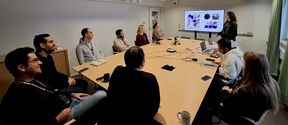€17 million fund backs 170 projects to develop disruptive solutions to key societal challenges

ATTRACT, a Horizon 2020 research and innovation project funded by the European Union and backed by a consortium of 9 partners including Aalto University, has announced 170 breakthrough ideas which will each receive €100,000 to develop technologies to change society. A kick-off meeting being held at CERN in Geneva will start the clock on a one-year countdown for the selected proposals to prove the scientific merit and innovation potential of their disruptive detection and imaging technologies.
The projects selected for funding were drawn from a pool of more than 1,200 proposals from researchers and entrepreneurs in scientific and industrial organisations across the world. An Independent Research, Development and Innovation (R&D&I) Committee used a rigorous evaluation process to determine which of these proposals should receive €100,000 of funding.
‘170 breakthrough ideas were selected based on a combination of scientific merit, innovation readiness and potential societal impact,’ explained Sergio Bertolucci, chair of ATTRACT’s Independent R&D&I Committee. ‘The idea is to speed up the process of developing breakthrough technologies and applying them to address society’s key challenges.’
3 Aalto-related projects were among those selected:
Professor Yu Xiao’s project DEBARE aims to develop a novel, AI-based intelligent sensing platform that is capable of more complex activity recognition and learning than existing technologies. One potential use case is augmented reality smart gloves for industrial maintenance and assembly. The project partner is Hitseed, a Finnish company with expertise in smart sensors. ‘By encouraging collaboration between universities and industry – especially SMEs– who are interested in R&D as well as commercialisation, ATTRACT enables researchers and companies to test and pilot their breakthrough ideas,’ said Professor Yu Xiao.
In Professor Hele Savin’s project, SUGER, a prototype radiation sensor based on new ‘black germanium’ technology will be fabricated. The novel sensor technology aims to get record-high sensitivity, especially for infrared radiation. The application areas include medicine, and nuclear safety and security. Program partners include the Latvian-based company Baltic Scientific Instruments Ltd and Finland-based Pixpolar.
Professor Jyri Hämäläinen and his research group aim to design a monitoring system based on Visible Light Communication technology for indoor areas. If successful, the team hope that it will pave the way for the implementation of new applications like monitoring technology and motion detection. The project partner is Barcelona-based research center Centre Tecnològic de Telecomunicacions de Catalunya (CTTC).
As a part of the ATTRACT initiative, Aalto University will also organise courses for Master's degree students. Students will be challenged to utilise technology developed in ATTRACT projects to design and create consumer products that can be commercialised. The project aims to increase the societal significance of the innovations developed through the ATTRACT program by establishing collaboration between breakthrough technology and student work. Aalto has a long history of providing learning projects that are done in cooperation with the industry partners. The model has attracted more and more interest in the academic world every year. Therefore, the ATTRACT initiative takes Finnish training expertise to the attention of high-tech developers at European level. The student projects are implemented in cooperation with different universities that are part of the Design Factory Global Network.
From augmented reality to smart sensors and devices, many of the chosen 170 ideas will develop disruptive technologies that could help improve clinical diagnosis, health monitoring and personalised treatments for diseases such as cancer, Alzheimer’s, or malaria, as well as heart and neurological conditions.
Interdisciplinary teams of researchers, entrepreneurs and companies from across the globe will also develop novel sensors and devices that will enable radical innovations in many other sectors with high market potential. New technologies will include smart devices for environmental monitoring, green solutions to fight climate change, advanced applications for citizens, smart systems for manufacturing processes, and disruptive technologies to expand our scientific knowledge.
Details of the 170 funded projects are being released today, and are grouped into four broad categories; data acquisition systems and computing; front-end and back-end electronics; sensors; and software and integration.
Most of the breakthrough ideas, — 64% — will develop next-generation technologies involving sensors, 16% will focus on data-acquisition systems and computing, 12% are software and integration projects, and 8% will develop the front and back-end electronics needed for the interfaces of sensors and imaging technology.
The 170 breakthrough projects funded by ATTRACT will have one year to show that their disruptive ideas are worth further investment, and will present their results at a conference in autumn 2020 in Brussels. During the one-year development phase, business and innovation experts from the ATTRACT Project Consortium’s Aalto University, EIRMA, and ESADE Business School will help the project teams explore how their breakthrough technologies can be transformed into innovations with strong market potential.
Media contacts
Virginia Mercouri
Media Adviser, Science|Business.
Tel: +32 489 095 044
Email: virginia.mercouri@sciencebusiness.net
Anna Alsina Bardagí
Content Director, ESADE Business School
Tel: +34 690 957 506
Email: anna.alsina@esade.edu
Frequently Asked Questions about ATTRACT | ATTRACT Media Room
Principal Investigators with ATTRACT grants
Read more news
Apply to be a guest professor or visiting researcher at the Université Grenoble Alpes
Unite! partner, Université Grenoble Alpes (UGA) has opened a call to host international professors and researchers for short stays.
Floriane presents research findings on denim recycling
On 15 January 2026, Floriane Jacquin, an intern with the Textile Chemistry Group at Aalto University, presented the findings.
Postdoctoral researcher Eloi Moliner makes history as a 5-time award winner
Eloi Moliner is one of the most decorated doctoral researchers in Aalto University's history – we would like to highlight his success and contributions to the field of audio signal processing






